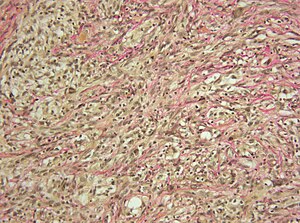Gliosarcoma
| Gliosarcoma | |
|---|---|
 |
|
| Micrograph showing a gliosarcoma. Elastic van Gieson's stain. | |
| Classification and external resources | |
| ICD-O | M9442/3 |
Gliosarcoma is a rare type of glioma, a cancer of the brain that comes from glial, or supportive, brain cells, as opposed to the neural brain cells. Gliosarcoma is a malignant cancer, and is defined as a glioblastoma consisting of gliomatous and sarcomatous components.
It is estimated that approximately 2.1% of all glioblastomas are gliosarcomas. Although most gliomas rarely show metastases outside the cerebrum, gliosarcomas have a propensity to do so, most commonly spreading through the blood to the lungs, and also liver and lymph nodes.
Gliosarcomas have an epidemiology similar to that of glioblastomas, with the average age of onset being 54 years, and males being affected twice as often as females. They are most commonly present in the temporal lobe.
![]() This article incorporates public domain material from the U.S. National Cancer Institute document "Dictionary of Cancer Terms".
This article incorporates public domain material from the U.S. National Cancer Institute document "Dictionary of Cancer Terms".
...
Wikipedia
